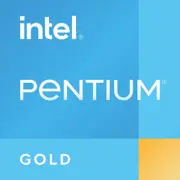Intel Pentium Gold G5620

Intel Pentium Gold G5620: Budget Processor for Basic Tasks in 2025
Updated: April 2025
1. Key Specifications: Architecture and Performance
Architecture and Manufacturing Process
The Intel Pentium Gold G5620 processor belongs to the Coffee Lake generation (2018-2019) and is built on a 14 nm manufacturing process. Despite the age of the architecture, it remains relevant for budget builds due to its low power consumption (TDP of 54W) and support for Hyper-Threading: 2 cores and 4 threads.
Key Features
- L3 Cache: 4 MB — sufficient for simple tasks but limited for complex multithreading workload.
- Integrated Graphics: Intel UHD Graphics 630 with a base frequency of 350 MHz (up to 1.15 GHz in Turbo mode). It supports 4K via HDMI/DisplayPort, but is weak for gaming.
- Performance: In Geekbench 6, the processor scores 763 points in single-core and 1456 in multi-core tests. This level is adequate for office tasks and light multitasking.
Practical Example: For working with documents, browsing (10+ tabs), and watching videos in 1080p, the processor handles tasks smoothly. However, running Photoshop + Zoom + Spotify may lead to some stuttering.
2. Compatible Motherboards
Socket and Chipsets
The processor uses the LGA 1151-v2 socket, compatible only with 300 series chipsets:
- H310/B360/H370: Budget motherboards (e.g., ASRock H310CM-HDV, ~$60-70). Suitable for basic builds but lack overclocking capabilities and have a minimal number of ports.
- Z370/Z390: Enthusiast boards (ASUS Prime Z390-P, ~$120-140). Overkill for Pentium, but allow for future installation of a more powerful CPU.
Selection Considerations
- Check the BIOS version: Older boards may require updates to work with Coffee Lake.
- In 2025, new motherboards for LGA 1151-v2 are no longer being produced. Look for leftover stock or refurbished options.
3. Supported Memory
Types and Modes
The processor works with DDR4-2400 MHz in dual-channel mode. DDR5 support is absent.
- Recommended Size: 8-16 GB. For instance, a 2x8 GB Crucial DDR4-2400 kit (~$40-50).
- Important: H310/B360 motherboards often have only two memory slots.
Example: For Windows 11 and office applications, 8 GB is enough, but for comfortable use with Chrome + applications, 16 GB is better.
4. Power Supply Recommendations
Power Calculation
With a TDP of 54W, the Pentium Gold G5620 does not require a powerful PSU. Even a budget power supply of 400W will be sufficient.
- Without a discrete graphics card: 300-400W (e.g., EVGA 400 N1, ~$35).
- With a graphics card: For a GPU like the NVIDIA GTX 1650 (TDP 75W), choose a 500W PSU (Corsair CX550, ~$60).
Tip: Don’t skimp on the PSU. Faulty models can damage components. Look for 80+ Bronze or higher certifications.
5. Pros and Cons of the Processor
Pros:
- Low price (~$70-80 in 2025).
- Energy efficiency: suitable for compact and silent builds.
- Integrated graphics: does not require a separate graphics card for basic tasks.
Cons:
- Only 2 cores: weak multithreading performance.
- No PCIe 4.0 support: maximum SSD speed is limited.
- Outdated platform: upgrade is only possible to 8th/9th generation processors.
6. Use Cases
Office and Multimedia
- Working with documents, browsing, and watching videos in 1080p.
- Connecting to a TV as a media center (4K HDR via HDMI 2.0).
Light Gaming
- Playing games like CS:GO, Dota 2, and Minecraft on low settings (30-50 FPS).
- For games like Cyberpunk 2077 or Elden Ring, a discrete graphics card (e.g., GTX 1660) is required.
What Not to Expect:
- Streaming, video editing, or 3D rendering.
7. Comparison with Competitors
AMD Ryzen 3 3200G (4 cores/4 threads, Vega 8, ~$90):
- Better for multithreaded tasks (+20% in Cinebench R23).
- Vega 8 graphics outperform UHD 630 by 30-40%.
Intel Core i3-10100 (4 cores/8 threads, ~$110):
- Higher gaming performance (+35% in Geekbench 6 Multi-Core).
- Supports DDR4-2666 and PCIe 3.0.
Conclusion: The Pentium G5620 is advantageous only within a strict budget. If you can add $20-30, it’s better to choose the Ryzen 3 or Core i3.
8. Practical Assembly Tips
Budget Configuration (Example):
- Motherboard: ASRock B360M-HDV (~$65).
- Memory: Patriot Signature 16 GB DDR4-2400 (~$45).
- Storage: Kingston A400 480 GB SSD (~$35).
- PSU: EVGA 450 BR (~$40).
- Case: Cooler Master MasterBox Q300L (~$50).
Optimizations:
- For quiet operation, replace the stock cooler with a Deepcool GAMMAXX 400 (~$20).
- If more graphics power is needed, add a used GTX 1050 Ti (~$80).
9. Final Conclusion: Who is the Pentium Gold G5620 For?
This processor is suitable for those needing a cheap and reliable PC for basic tasks:
- Office workers.
- Users setting up a media center or a PC for studying.
- Owners of older systems upgrading the CPU without changing the motherboard.
Why This Processor?
- Price under $80.
- No need for a discrete graphics card.
- Sufficient for everyday tasks in 2025.
However, if your budget allows, consider more modern AMD APUs or the 10th generation Core i3 — they will provide performance headroom for the future.
Prices are valid as of April 2025 for new devices. Listed models may be discontinued — look for similar alternatives with comparable specifications.
Basic
CPU Specifications
Memory Specifications
GPU Specifications
Miscellaneous
Benchmarks
Compared to Other CPU
Share in social media
Or Link To Us
<a href="https://cputronic.com/en/cpu/intel-pentium-gold-g5620" target="_blank">Intel Pentium Gold G5620</a>